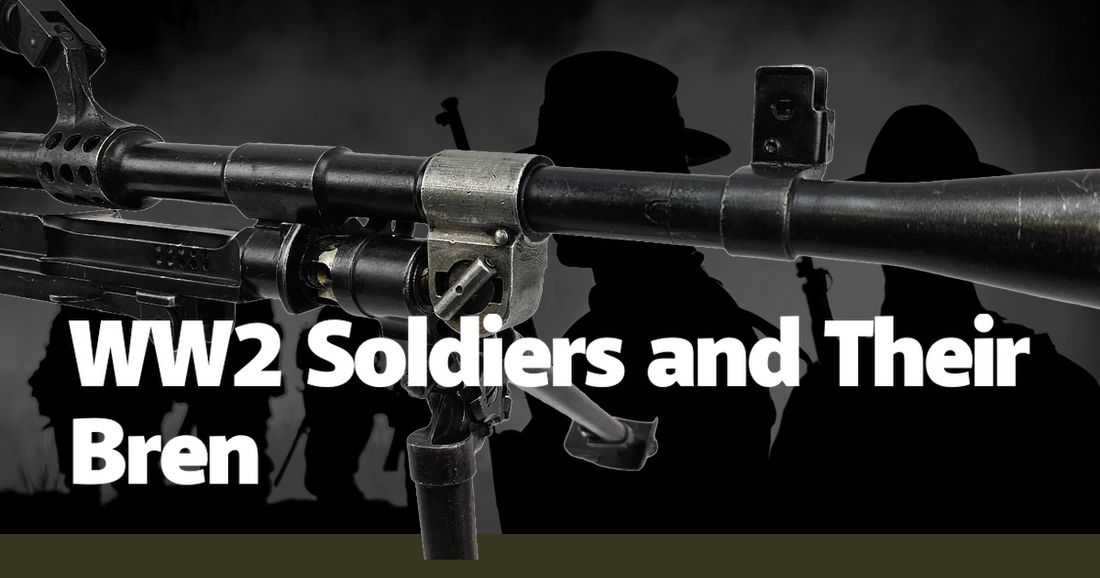In the crucible of World War II, soldiers on the front lines found themselves reliant not only on their training and courage but also on the tools of war that they carried into battle. Among these tools, the Bren light machine gun stood out as a symbol of reliability and firepower. The Bren, officially known as the Bren Gun, derived its name from the Czech city of Brno, where it was originally designed, and Enfield, where it was modified and produced for the British Army. This weapon became a cornerstone of infantry tactics and was beloved by the soldiers who wielded it. Its reputation for accuracy and dependability earned it a place of honor among the myriad weapons of the Second World War.
The Bren gun was chambered for the standard British .303 cartridge and featured a top-mounted 30-round magazine. This unusual design allowed for a clear line of sight and improved balance, making it easier for soldiers to fire from a prone position. The gun's design also included a quick-change barrel feature, which was critical during prolonged engagements where barrel overheating could be a fatal flaw. Soldiers appreciated this practical design, knowing that the Bren would not fail them in the heat of battle. The gun's bipod provided stability, allowing for sustained fire and making it an effective suppressive weapon. This combination of features made the Bren an indispensable asset in both offensive and defensive operations.
One vivid example of the Bren’s impact can be seen in the Battle of El Alamein. British and Commonwealth forces, entrenched in the harsh desert landscape, faced the formidable Afrika Korps led by General Erwin Rommel. The Bren's ability to deliver sustained, accurate fire played a crucial role in holding defensive positions and repelling enemy advances. Soldiers recount how the Bren's steady rhythm became a source of reassurance amid the chaos of battle. Its reliability under the grueling conditions of the North African campaign helped turn the tide in favor of the Allies, exemplifying the gun's importance in pivotal moments of the war.
The Bren gun was not just a tool of war; it was a companion to the soldiers who carried it. Anecdotes from veterans often highlight the bond between man and machine. One such story comes from a British infantryman named Corporal Bill Hurst, who served in the Italian Campaign. Hurst spoke of his Bren as if it were a fellow soldier, recounting how he named it "Betsy" and trusted it implicitly. During a fierce engagement near Monte Cassino, Hurst's unit was pinned down by enemy fire. It was Betsy that provided the suppressive fire necessary to allow his comrades to flank the enemy position. Hurst’s story is a testament to the personal connections soldiers formed with their weapons, seeing them as lifelines in the direst of circumstances.
The Bren's versatility was another factor that contributed to its esteemed status. It was used in a variety of roles, from infantry support to anti-aircraft defense. Its adaptability made it a favorite among different branches of the military. In the jungles of Burma, the Bren was modified with a larger magazine to counter the dense foliage and close-quarter combat typical of the region. These modifications allowed soldiers to maintain a higher rate of fire, crucial in the unpredictable and often ambush-prone environment. The adaptability of the Bren ensured that it could meet the demands of any theater of war, from the deserts of North Africa to the forests of Europe and the islands of the Pacific.
The psychological impact of the Bren on both friend and foe cannot be underestimated. For Allied soldiers, the distinct sound of the Bren's firing was a morale booster, a reminder that they had a reliable source of firepower on their side. Conversely, for Axis forces, the Bren's distinctive staccato was often a harbinger of relentless and accurate fire that could decimate their ranks. This dual psychological effect amplified the Bren's tactical value. German soldiers, in particular, came to recognize the Bren as a formidable adversary, often prioritizing its elimination in combat scenarios. The respect it commanded on both sides of the battlefield is a testament to its effectiveness and reliability.
Despite its many strengths, the Bren was not without its challenges. Its weight, around 23 pounds with a loaded magazine, made it cumbersome for soldiers on long marches. The top-mounted magazine, while advantageous for balance and sightlines, also made the gun more conspicuous and somewhat awkward in tight spaces. Yet, these drawbacks were often overshadowed by the Bren's performance in combat. Soldiers adapted to its quirks, developing techniques to mitigate its weight and bulk. The British Army's rigorous training ensured that soldiers were proficient in the Bren's use, turning potential disadvantages into manageable aspects of its operation.
As World War II drew to a close, the Bren gun had cemented its legacy. It continued to serve in various capacities long after the war, seeing action in conflicts such as the Korean War and the Malayan Emergency. Its longevity is a testament to the soundness of its design and the high regard in which it was held by those who used it. The Bren's story is not just one of a weapon, but of the soldiers who relied on it, trusted it, and in many cases, owed their lives to it. The Bren gun remains an iconic symbol of World War II, representing the ingenuity, resilience, and unwavering spirit of the soldiers who fought with it by their side.

